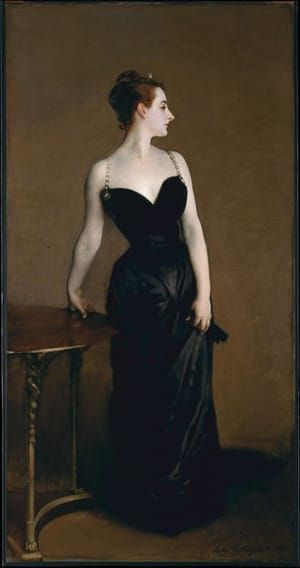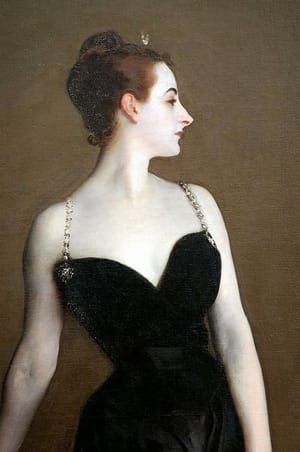

Madame X (Madame Pierre Gautreau), 1883-1884
John Singer Sargent
It was a dress that caused the greatest stir of Sargent's career. Painting a portrait of Madame Pierre Gautreau, Sargent emphasised her daring personal style, showing the right strap of her gown slipping from her shoulder. When finally displayed at the Salon of 1884, the portrait received scathing reviews and the subject and her family were mortified. Sargent repainted the shoulder strap and kept the work for over 30 years. When, eventually, he sold it to the Metropolitan Museum of Art in New York, he commented, "I suppose it is the best thing I have done," but asked the Museum to disguise the sitter's name.
(http://poulwebb.blogspot.nl/2014/03/john-singer-sargent-part-5.html)
When the painting first appeared at the Paris Salon under the title Portrait de Mme *** in 1884, people were shocked and scandalized... At the time, her pose was considered sexually suggestive. As originally exhibited, one strap of her gown had fallen down her right shoulder, suggesting the possibility of further revelation... Later, Sargent overpainted the shoulder strap...In 1916, Sargent sold the painting to the Metropolitan Museum...
(https://en.wikipedia.org/wiki/Portrait_of_Madame_X)
When Madame X was shown at the Salon of 1884 it became instantly a salacious painting and a scandal in French society as a result of its sexual suggestiveness of her pose and the pail pasty color of her skin. The "X" of Madame X was actually Madame Gautreau, whose reputation was apparently destroyed, and John left France shortly to never truly regain his former standing as the darling of Paris. (Read the complete story at http://hoocher.com/john_singer_sargent/john_singer_sargent.htm )
Although Sargent painted, showed, and won praise for both portraits and subject pictures at the salons between 1877 and 1882, commissions for portraits increasingly demanded his attention and defined his reputation. Sargent's best-known portrait, Madame X, which he undertook without a commission, enlisted a palette and brushwork derived from Velázquez; a profile view that recalls Titian; and an unmodulated treatment of the face and figure inspired by the style of Édouard Manet and Japanese prints. The picture's novelty and quality notwithstanding, it was a succès de scandale in the 1884 Salon, provoking criticism for Sargent's indifference to conventions of pose, modelling, and treatment of space, even 20 years after Manet's pioneering efforts.
(https://www.metmuseum.org/toah/hd/sarg/hd_sarg.htm)
82 x 43 in
Uploaded on Jul 2, 2013 by Jamie Jimenez
John Singer Sargent
artistArthur
Wait what?














